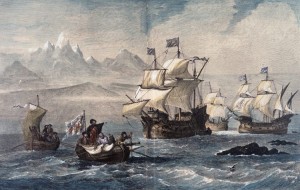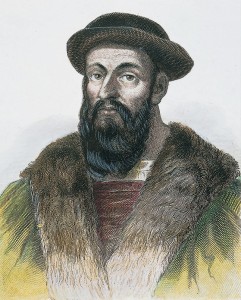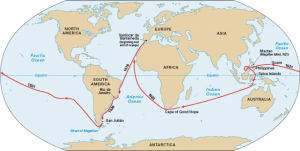Magellan 500
Friday, September 20th, 2019September 20, 2019
On Sept. 20, 1519, 500 years ago today, the Portuguese sea captain Ferdinand Magellan sailed westward from Spain with a small fleet, hoping to find an alternate sea route to the rich Spice Islands of Indonesia. Magellan reached and crossed the Pacific Ocean, but he never saw the Spice Islands—nor did he live to finish the voyage. Members of his crew, however, returned to Spain from the east, becoming the first people to circumnavigate (sail all the way around) the world. Many scholars consider the voyage the greatest navigational feat in history.

The Portuguese explorer Ferdinand Magellan led the first expedition that sailed around the world. This engraving shows Magellan and his crew in October 1520 as they sail through the strait that separates the islands of Tierra del Fuego from mainland South America. The Strait of Magellan, as it is now called, provided a shortcut between the Atlantic and Pacific oceans. Credit: Discovery of The Magellan-Strait (1880), colored wood engraving by unknown artist (© SuperStock)
Magellan, an experienced seaman and soldier, studied astronomy and navigation. His studies convinced him that he could reach the Spice Islands by sailing west around the southern tip of South America. He believed such a route would be shorter than the eastward voyage around the southern tip of Africa and across the Indian Ocean. Magellan asked the king of Portugal to support the voyage, but the king refused. Like Christopher Columbus 27 years earlier, however, Magellan found a sponsor in the monarch of Spain, and he began planning the expedition.

Ferdinand Magellan died in the Philippines in 1521, but members of his crew completed the first circumnavigation of the world in 1522. Credit: Granger Collection
On Sept. 20, 1519, Magellan left Spain with about 240 men and five ships: Concepcion, San Antonio, Santiago, Trinidad, and Victoria. The fleet sailed across the Atlantic Ocean to the coast of modern day Brazil and followed the South American coast to southern Argentina. A storm destroyed Santiago, and there were problems with the sometimes mutinous crew, but Magellan discovered a passage around the tip of South America to the Pacific—a passage known ever since as the Strait of Magellan. The crew of San Antonio mutinied and returned to Spain, but the three remaining ships sailed out of the strait and into the ocean. Magellan named the ocean the Pacific, which means peaceful, because it appeared calm compared with the stormy strait.

Click to view larger image
This map traces Magellan’s fleet as it completed the first circumnavigation of the world from 1519 to 1522. Credit: WORLD BOOK map
Sailing across the vast Pacific involved great hardship for Magellan and his crew. No Europeans had sailed across the Pacific before them. Consequently, the islands in the Pacific, where ships could resupply with food and water, were unknown. The ships sailed for 98 days without seeing any land except two uninhabited islands. Their food gave out, and their water supply became contaminated. They ate rats that infested their ships, oxhide leather, and sawdust to avoid starvation. Most of the crew suffered from scurvy, a disease caused by a lack of vitamin C in the diet. Several men died before the fleet reached Guam on March 6, 1521.
Conflicts with the people of Guam and the nearby island of Rota prevented Magellan from fully resupplying his ships. But the crew seized enough food and water to continue on to the Philippines. Magellan and his crew remained in the Philippines for several weeks, and close relations developed between them and the islanders. On April 27, 1521, however, Magellan was killed when he took part in a battle between rival Filipino groups on the island of Mactan.
With only about 110 crew members remaining, Magellan’s men abandoned Concepcion, and the two remaining vessels, Trinidad and Victoria, sailed to the Spice Islands, where they were loaded with valuable spices. The leaders of the fleet then decided that the two ships should make separate return voyages.
Trinidad sailed eastward across the Pacific to the Isthmus of Panama. Bad weather and disease disrupted the voyage, and more than half the crew died. The survivors made the terrible trip across the Pacific again, only to be detained in the Spice Islands. Victoria went the other way, continuing its westward voyage across the Indian Ocean. Victoria also experienced great hardship, and many of the crew died, but the ship finally reached Spain on Sept. 6, 1522, nearly three years after the voyage had begun. Only 18 sailors lived to complete the circumnavigation.
Magellan proved that it was possible to reach the Spice Islands by sailing westward. The discovery of the Strait of Magellan led to future European voyages across the Pacific and around the world.


